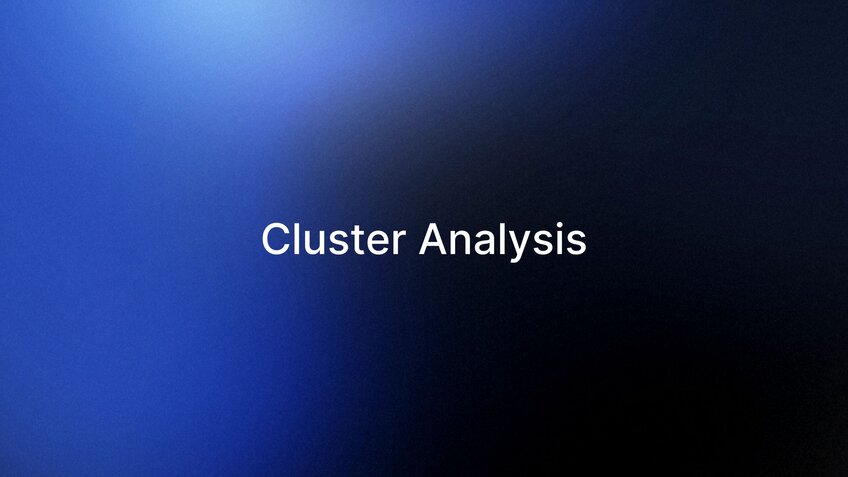<- Back to Glossary
Cluster Analysis
Definition, types, and examples

What is Cluster Analysis?
Cluster Analysis is a powerful data mining technique used to group similar objects or data points into clusters, revealing hidden patterns and structures within datasets. This unsupervised learning method plays a crucial role in various fields, from market segmentation to image recognition, by identifying natural groupings in data without predefined labels. As businesses and researchers grapple with ever-increasing volumes of data, cluster analysis provides a means to distill meaningful insights and simplify complex datasets into manageable, interpretable groups.
Definition
Cluster Analysis, also known as clustering, can be defined as the process of partitioning a set of data objects or observations into subsets called clusters, so that the data in each cluster share some common trait - often proximity according to some defined distance measure. The primary goal of cluster analysis is to maximize the similarity of data points within a cluster while maximizing the dissimilarity between clusters. Key aspects of cluster analysis include:
1. Similarity Measure: A method to quantify how similar or dissimilar two data points are. Common measures include Euclidean distance, Manhattan distance, and cosine similarity.
2. Clustering Algorithm: The specific method used to group data points into clusters based on their similarity.
3. Number of Clusters: Determining the optimal number of clusters, which can be predefined or automatically determined by the algorithm.
4. Cluster Validation: Evaluating the quality and meaningfulness of the resulting clusters.
5. Interpretation: Analyzing the characteristics of each cluster to derive insights about the underlying data structure.
Cluster analysis is an iterative process that often involves experimenting with different algorithms and parameters to find the most meaningful and useful groupings for a given dataset and problem domain.
Types
Cluster analysis encompasses various algorithms and approaches, each suited to different types of data and analytical goals:
1. Partitioning Methods:
2. Hierarchical Methods:
3. Density-Based Methods:
4. Model-Based Methods:
5. Grid-Based Methods:
6. Fuzzy Clustering:
7. Spectral Clustering:
History
The development of cluster analysis spans several decades:
1930s: Anthropologists Driver and Kroeber perform one of the first cluster analyses.
1950s: Psychologists use clustering techniques for trait theory research.
1960s: The term "cluster analysis" is coined. The K-means algorithm is introduced by Stuart Lloyd.
1970s: Hierarchical clustering methods gain popularity. Ward's method for hierarchical clustering is developed.
1980s: Fuzzy clustering methods emerge. DBSCAN is introduced, addressing the limitation of finding non-globular clusters.
1990s: Model-based clustering approaches gain traction. The rise of data mining increases interest in clustering techniques.
2000s: Spectral clustering methods are developed. The growth of big data leads to new challenges and adaptations in clustering algorithms.
2010s: Machine learning advancements lead to more sophisticated clustering techniques, including deep learning-based clustering.
2020s: The integration of cluster analysis with other AI techniques, such as reinforcement learning and neural networks, opens new frontiers in data analysis and pattern recognition.
Examples
Cluster analysis finds applications across various domains:
1. Market Segmentation: Grouping customers based on purchasing behavior, demographics, and psychographics to tailor marketing strategies.
2. Image Segmentation: Partitioning digital images into multiple segments or objects, crucial in computer vision and medical imaging.
3. Anomaly Detection: Identifying unusual patterns in data, used in fraud detection and network security.
4. Bioinformatics: Grouping genes with similar expression patterns in genomic data analysis.
5. Urban Planning: Clustering neighborhoods based on socioeconomic factors to inform policy decisions.
6. Document Classification: Grouping similar documents in large text datasets, useful in information retrieval and topic modeling.
7. Recommender Systems: Clustering users or items to provide personalized recommendations in e-commerce and content platforms.
Tools and Websites
Numerous tools and platforms facilitate cluster analysis:
1. Python Libraries:
2. R Packages:
3. Julius: A tool enhancing cluster analysis by automating the identification of natural groupings within data, providing intuitive visualizations, and delivering actionable insights for better decision-making.
4. MATLAB: Statistics and Machine Learning Toolbox - Includes functions for various clustering methods.
5. RapidMiner: A data science platform with built-in clustering operators.
6. Weka: An open-source machine learning software that includes clustering algorithms.
7. IBM SPSS Statistics: Offers a range of clustering techniques for statistical analysis.
8. Orange: An open-source data visualization and analysis tool with clustering capabilities.
In the Workforce
Cluster analysis skills are valuable across various roles:
1. Data Scientists: Use clustering in exploratory data analysis and to build predictive models.
2. Market Researchers: Apply clustering to segment customers and identify target markets.
3. Bioinformaticians: Utilize clustering in analyzing genetic data and protein structures.
4. Business Analysts: Employ clustering to identify patterns in business data and inform strategy.
5. Image Processing Engineers: Use clustering in developing image segmentation algorithms.
6. Cybersecurity Analysts: Apply clustering in detecting anomalies and potential security threats.
7. Urban Planners: Utilize clustering to analyze demographic and geographic data for city planning.
Frequently Asked Questions
How does cluster analysis differ from classification?
Cluster analysis is an unsupervised learning method that groups data without predefined labels, while classification is a supervised learning method that assigns data to predefined categories.
How do you determine the optimal number of clusters?
Methods include the elbow method, silhouette analysis, and gap statistics. The choice often depends on the specific dataset and problem context.
What are the limitations of cluster analysis?
Limitations include sensitivity to initial conditions in some algorithms, difficulty in determining the true number of clusters, and challenges in interpreting high-dimensional clusters.
Can cluster analysis handle mixed data types?
Yes, but it requires careful consideration of similarity measures. Some algorithms are specifically designed for mixed data types.
How is cluster analysis used in artificial intelligence?
In AI, clustering is used for data preprocessing, feature learning, and as a component in more complex algorithms. It's particularly useful in unsupervised learning scenarios and for reducing the dimensionality of large datasets.
